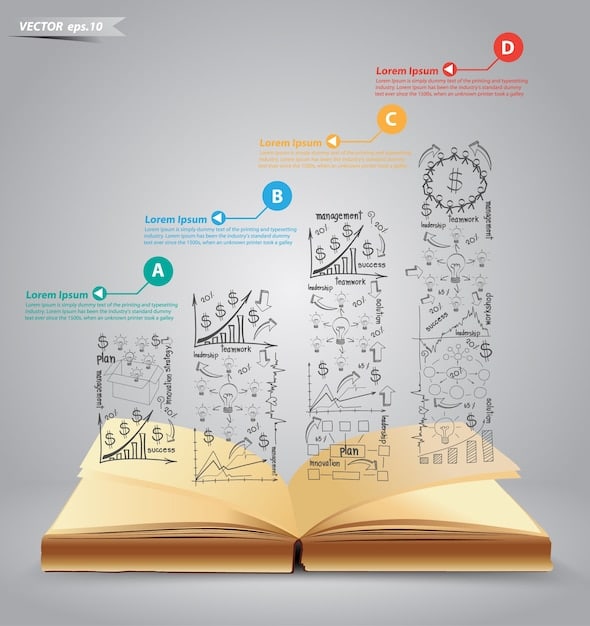How Narratology Explains Narrative Structure In American Novels

Narratology significantly enhances our understanding of narrative structure in American novels by providing a framework to analyze narrative elements such as point of view, plot, and character development, leading to a deeper appreciation of how stories are constructed and interpreted.
Have you ever wondered what makes a novel truly captivating? The secret often lies in its narrative structure. But
how does narratology enhance our understanding of narrative structure in American novels? It’s a question that unlocks a deeper appreciation for the art of storytelling.
Let’s delve into how narratology – the study of narrative – provides invaluable tools for analyzing and interpreting the intricate layers of American novels, revealing the choices authors make to craft compelling narratives.
Understanding Narratology and Its Significance
Narratology, at its core, is the study of how stories work. It provides a systematic approach to analyzing narratives, examining elements such as plot, character, point of view, and theme. Understanding narratology is crucial for anyone seeking a deeper appreciation of literature, especially American novels.
Key Concepts in Narratology
Narratology introduces several key concepts that are essential for analyzing narrative structure. These concepts help us understand how authors construct their stories and how readers interpret them.
- Focalization: Refers to the perspective through which the narrative is presented, influencing how readers perceive events and characters.
- Narrative Voice: The voice telling the story, which can be first-person, third-person, or omniscient, each offering a different level of insight.
- Plot Structure: The arrangement of events in a story, often following patterns such as exposition, rising action, climax, falling action, and resolution.
These concepts equip readers with a critical lens to dissect and appreciate the complexities of narrative storytelling. By understanding focalization, narrative voice, and plot structure, one can better grasp the author’s intentions and the effects of their choices.
In essence, narratology provides the toolkit necessary to dissect and appreciate the architecture of stories, enabling a richer appreciation for the nuances in American novels. This analytical approach is vital for both literary scholars and avid readers.
The Role of Narratology in Analyzing American Novels
When applied to American novels, narratology offers a powerful framework for understanding how authors construct meaning and engage readers. It allows us to move beyond surface-level reading and appreciate the deliberate choices that shape the narrative.
Examining Narrative Techniques
Narratology helps us examine the specific techniques used by American novelists to create their narratives. By analyzing elements such as point of view and narrative voice, we can gain a deeper understanding of the author’s strategies.
- Point of View: Analyzing whether a novel is told from a first-person, third-person, or omniscient perspective reveals how information is filtered and interpreted.
- Character Development: Narratology helps us understand how characters are introduced, developed, and how their actions drive the plot forward.
- Temporal Manipulation: Exploring how authors use techniques like flashbacks and flash-forwards can reveal complex emotional landscapes and thematic concerns.
By closely examining these narrative techniques, we can unravel the layers of meaning embedded in American novels. Narratology allows us to see how these techniques contribute to the overall impact and effectiveness of the story.
In conclusion, applying narratology to American novels allows for a more rigorous and nuanced understanding of how narratives function, enriching our reading experience and analytical capabilities. Exploring each technique allows us to appreciate the precision and artistry involved in constructing a narrative.
How Does Narratology Enhance Our Understanding Of Narrative Structure In American Novels?
The core question remains: How does narratology enhance our understanding of narrative structure in American novels? Narratology provides the tools to break down the complex interplay of narrative elements, leading to a more profound appreciation of literary craftsmanship.
Uncovering Hidden Meanings
Narratology is pivotal in uncovering latent or hidden meanings within American novels. By systematically analyzing the structure, we can unearth subtle thematic undercurrents and authorial intentions that might otherwise remain obscured.
- Thematic Resonance: Analyzing narrative structure allows us to identify recurring themes and motifs, enhancing our understanding of the novel’s underlying message.
- Authorial Intention: Examining narrative choices can reveal the author’s intended effects on the reader, such as creating suspense or eliciting empathy.
- Cultural Context: Understanding the narrative structure in the context of its time can shed light on the cultural and social influences shaping the story.
Narratology transforms the reading experience from a passive consumption of plot events to an active engagement with the text’s deeper layers. By focusing on structure, readers can decode the cultural context and authorial intent woven into the narrative.
Thus, narratology enhances our ability to interpret American novels by revealing hidden meanings and enriching our understanding of the text’s complexity. Delving into these layers allows a richer exploration of underlying cultural contexts and authorial intentions.

Point of View and Narrative Voice in American Novels
Point of view and narrative voice are crucial elements in shaping the narrative structure of American novels. Narratology provides the framework to analyze how these elements influence the reader’s experience and interpretation of the story.
Analyzing Focalization
Focalization, or the perspective through which the story is told, is a key aspect of narrative analysis. Understanding who is telling the story and from what vantage point greatly affects our interpretation.
- First-Person Narration: Offers an intimate, subjective view, often coloured by the narrator’s biases and limited knowledge.
- Third-Person Limited Narration: Provides a single character’s perspective, allowing readers to access their thoughts and feelings without being omniscient.
- Third-Person Omniscient Narration: Offers a broad, all-knowing perspective, capable of revealing the thoughts and feelings of multiple characters.
Through narratology, we learn to appreciate how the choice of focalization shapes the narrative and influences our emotional investment in the characters and events. This understanding allows for a deeper, more nuanced interpretation of the novel’s themes and intentions.
In conclusion, narratology helps us understand how point of view and narrative voice significantly impact the structure and interpretation of American novels. Analysis of focalization offers a deeper insight into the author’s strategic narrative choices.
Character Development and Plot Structure
Character development and plot structure are two interconnected elements that narratology examines in American novels. Analyzing how characters evolve and how the plot unfolds enhances our understanding of the narrative.
Interplay of Character and Plot
The interplay between character and plot is a central focus in narratology. Analyzing how characters’ actions influence the plot, and vice versa, reveals deeper thematic meanings.
- Character Arcs: Understanding how characters change and grow throughout the narrative provides insight into the novel’s themes and messages.
- Plot Devices: Analyzing the use of plot devices such as foreshadowing and red herrings enhances our appreciation of the author’s craft.
- Narrative Tension: Examining how authors create and sustain narrative tension through plot and character interactions keeps readers engaged.
By understanding these dynamics, readers can better appreciate how authors craft compelling narratives that resonate on both an emotional and intellectual level. This interplay contributes significantly to the overall narrative complexity and richness.
In summary, narratology emphasizes the importance of character development and plot structure in shaping the narrative arc of American novels. This focus allows for a richer appreciation of the complex interplay between character actions and plot progression.
Applying Narratology: Case Studies in American Novels
To illustrate how does narratology enhance our understanding of narrative structure in American novels, let’s examine specific examples. Applying narratological tools to well-known works can illuminate the impact of narrative choices.
| Key Point | Brief Description |
|---|---|
| 🔎 Narrative Voice | Analyzing who tells the story and their perspective to uncover biases. |
| 🎭 Character Arcs | Tracking how characters evolve and impact the plot’s progression. |
| 📜 Plot Structure | Examining exposition, rising action, climax, falling action and resolution. |
| 💡 Thematic Resonance | Identifying motifs that enhance the understanding of the novel’s message. |
Frequently Asked Questions
Narratology is the study of narrative structure and how stories convey meaning. It’s important because it offers tools to analyze elements like plot, character, and point of view, enhancing our understanding of literature.
Point of view determines how readers experience the story, shaping their perception of events and characters. First-person narration offers intimacy, while third-person provides a broader perspective.
Narratology allows us to analyze character arcs, motivations, and interactions, providing insights into how authors create compelling and relatable characters, thus enhancing character development in novels.
American novels often employ plot devices like foreshadowing, flashbacks, and suspense to engage readers. These techniques create tension and deepen our investment in the story’s outcome.
Yes, narratology is applicable across various genres. While the specific techniques may vary, the fundamental principles of analyzing narrative structure remain consistent, enhancing our appreciation of all forms of storytelling.
Conclusion
In summary, how does narratology enhance our understanding of narrative structure in American novels? By providing a systematic framework, narratology allows us to dissect and appreciate the deliberate choices authors make in crafting their stories, leading to a more profound and nuanced reading experience.





